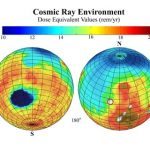U.S. Department of Transportation Federal Aviation Administration Advisory Circular
Subject: Date: March 5, 1990 AC No: 120-52
RADIATION EXPOSURE OF Initiated by: AAM-624 Change:
AIR CARRIER CREWMEMBERS
1. PURPOSE. This circular provides (a) information on cosmic radiation and on air shipments of radioactive material as sources of ionizing radiation1 exposure during air travel; (b) guidelines for exposure to radiation; (c) estimates of the amounts of galactic cosmic radiation received on air carrier flights on various routes to and from, or within, the contiguous United States (table l); and (d) example calculations for estimating health risks from exposure to galactic cosmic radiation.
2. GENERAL. Ionizing radiation has always been part of the human environment. Sources of such radiation are the radionuclides (radioactive atoms) in our bodies and in the earth, and the cosmic radiation in the atmosphere. We are also exposed to ionizing radiation during some medical and dental procedures. Table 2 shows average dose equivalent2 rates from various sources of ionizing radiation encountered in the United States.
Air travelers are exposed to cosmic radiation levels that are higher than the cosmic plus terrestrial radiation levels normally encountered on the ground. In the contiguous United States at ground level the average dose equivalent rate from cosmic plus terrestrial radiation is 0.06 microsievert (0.006 millirem) per hour (NCRP 1987b). At an altitude of 35,000 feet, for example, the dose equivalent rate from cosmic rays is about 6 microsieverts (0.6 millirem) per hour (O’Brien 1978, as revised).
Another source of radiation exposure during air travel is air shipments of radioactive material – mostly radiopharmaceuticals used in medical diagnosis and treatment.
1 Ionizing radiation is so named because each of its units has sufficient energy to eject an orbital electron from an atom and thus produce an ion (electrically charged atom or group of atoms). Examples of ionizing radiation are cosmic ray particles and xray or gammaray photons.
2 Dose equivalent is a measure of the biological harmfulness of ionizing radiation and takes into account the fact that equal amounts of absorbed energy from different types of ionizing radiation are not necessarily equally harmful. The present international unit of dose equivalent is the sievert. The sievert replaces the rem; 1 sievert = 100 rem.
1000 millisieverts = 1 sievert;
1000 microsieverts = 1 millisievert.
Table 1. DOSE EQUIVALENTS FROM GALACTIC COSMIC RADIATION RECEIVED ON AIR CARRIER FLIGHTS
Single nonstop one-way flight 950 block hours1
Highest
altitude, Air
feet in time, Block Microsieverts2 Millisieverts3
Origin – Destination thousands hours hours1 (millirem) (millirem)
1 2 3 4 5 6
Houston (IAH) Austin (AUS) 20 0.5 0.6 0.1 (0 01) 0.2 (20)
Seattle (SIA) Portland (PDX) 21 0.4 0.6 0.1 0.2
Miami (MIA) Tampa (TPA)| 24 0.6 0.9 0.4 0.4
St Louis (STL) Tulsa (TUL) 35 0.9 1.1 2.0 (0.20) 1.7 (170)
Tampa (TPA) St Louis (STL) 31 2.0 2.2 5.4 2.3
San Juan (SJU) Miami (MIA) 35 2.2 2.5 7.2 2.7
New Orleans (MSY) – San Antonio (SAT) 39 1.2 1.4 4.3 2.9
Denver (DEN) Minneapolis (MSP) 33 1.2 1.5 4.7 3.0
New York (JFK) San Juan PR (SJU) 37 3.0 3.5 13 (1.3) 3.5
Los Angeles (LAX) Honolulu (HNL) 35 5.2 5.6 22 3.7
Chicago (ORD) New York (JFK) 37 1.6 2.0 8.5 4.0
Honolulu (HNL) Los Angeles (LAX) 40 5.1 5.6 25 4.2
Washington, D.C. (IAD) Los Angeles (LAX) 35 4.7 5.0 24 4.6
Tokyo JA (RJAA) Los Angeles (LAX) 37 8.8 9.2 46 4.7
Los Angeles (LAX) Tokyo JA (RJAA) 40 11.7 12.0 62 4.9
New York (JFK) Chicago (ORD) 39 1.8 2.3 12 5.0
Minneapolis (MSP) New York (JFK) 37 1.8 2.1 11 5.0
London EN (EGKK) Dallas/Ft Worth (DFW) 39 9.7 10.1 53 5.0
Dallas/Ft Woth ((DFW) London EN (EGKK) 37 8.5 8.8 49 5.3
Seattle (SBA) Anchorage (ANC) 35 3.4 3.7 21 5.4
Lisbon PO (LPPT) New York (JFK) 39 6.5 6.9 41 5.6
Chicago (ORD) San Francisco (SFO) 39 3.8 4.1 26 6.0
Seattle (SEA) Washington, D.C. (IAD) 37 4.1 4.4 29 6.3
London EN (EGLL) New York (JFK) 37 6.8 7.3 49 6.4
New York (JFK) Seattle (SEA) 39 4.9 5.3 36 6.5
San Francisco (SFO) Chicago (ORD) 41 3.8 4.1 29 6.7
Tokyo JA (RJAA) New York (JFK) 41 12.2 12.6 91 6.9
London EN (EGLL) Los Angeles (LAX) 39 10.5 11.0 80 6.9
Chicago (ORD) London EN (EGLL) 37 7.3 7.7 56 6.9
New York (JFK) Tokyo JA (RJAA) 43 13.0 13.4 99 (9.9) 7.0
London EN (BGLL) Chicago (ORD) 39 7.8 8.3 62 7.1
Athens GR (LGAT) New York (JFK) 41 9.4 9.7 93 9.1 (910)
1 The block hours of a flight begin when the aircraft leaves the blocks before takeoff and end when it reaches the blocks after landing. We consider 950 block hours accumulated in 11 consecutive months as a representative work year
2 For each flight we estimated the dose equivalent for air time using one flight plan, taking into account changes in altitude and geomagnetic latitude from takeoff to touchdown.
3 Millisieverts in 950 block hours = (950 x microsieverts in one flight) / (1000 x block hours in one flight).
Table 2. AVERAGE NONOCCUPATIONAL DOSE EQUIVALENT RATES IN THE
UNITED STATES FROM VARIOUS SOURCES OF RADIATION1
Millisieverts (millirem)
per person in one year
Cosmic radiation (whole body) 0.27 (27)
Terrestrial radiation (whole body) 0.28 (28)
Naturally occurring radionuclides in the body
Bone marrow 0.50 (50)
Gonads 0.35 (35)
Inhaled radon (bronchial tissue) 24 (2400)
Diagnostic medical plus dental
Bone marrow (adults only,
radiographic & fluoroscopic) 1.0 (103)
Gonads (radiographic) 0.19 (19)
Millisieverts (millirem)
per film
Chest examination (radiographic)
Bone marrow (adults only)
Posterioranterior projection 0.046 (4.6)
Lateral projection 0.10 (10)
Gonads
Posterioranterior projection < 0.001 (< 0.1) 1 "Whole body" means that all parts of the body receive approximately the dose equivalent indicated. The dose equivalent to the bone marrow is of interest because of an association between radiation exposure of this tissue and development of leukemia, a cancer of the bloodforming organs. Gonad irradiation can cause genetic defects that may be passed on to future generations. Lung cancer can be caused by exposure of bronchial tissue to alpha radiation from decay products of inhaled radon. The air in many homes may contain hazardous amounts of radon. Dental examinations contribute only a small portion of the annual dose equivalent from diagnostic medical and dental procedures: 3 percent of the total to the bone marrow (adults) and less than 1 percent of the total to the gonads (entire population). HEW 1976, NCRP 1987b, Nero et al. 1986, Shleien et al. 1977. For the purposes of this circular, dose equivalents and other data for flights in one direction between two cities are considered representative of data for the other direction. Where data are given for flights in both directions between two cities, for example New York Chicago and Chicago New York (table 1), the annual dose equivalent received on roundtrip flights should be estimated by the average of the two oneway values. Except where otherwise indicated, galactic radiation estimates are dose equivalents to the bone marrow during conditions of average solar activity. Dose equivalents to the bone marrow are used to represent dose equivalents to the gonads or to an embryo or fetus. Additional information concerning the galactic radiation estimates is given in appendix 1. In estimating health risks, we used risk coefficients1 equivalent to or derived from those recommended by national or international organizations concerned with radiation effects on humans. However, the recommended coefficients are based on observations at much higher doses and dose rates than are associated with air travel, and this is a major source of uncertainty in the risk estimates. 3. COSMIC RADIATION. The cosmic radiation at air carrier flight altitudes consists of particulate radiation and photons produced when energetic charged particles2 - which originate for the most part outside the solar system - interact with the nitrogen, oxygen and other constituents of the earth's atmosphere. The charged particles entering the solar system and the secondary radiation they produce in the atmosphere are referred to collectively as galactic cosmic radiation. There is an approximate 11year cycle of rise and decline in the intensity of the galactic radiation incident on the atmosphere, with the intensity inversely related to solar activity (NCRP 1987b). The variation in intensity is effected by the magnetic fields generated by charged particles emanating from the sun. Calculations by O'Brien and McLaughlin (1972) indicate that at air carrier cruise altitudes over the contiguous United States the maximum galactic radiation dose equivalent rate exceeds the minimum by about 915 percent (based on data collected between 1960 and 1970). Charged particles are continuously ejected from the sun, but they are usually too low in energy to contribute to the radiation level at air carrier flight altitudes. On infrequent occasions, however, the numbers and energies of the ejected solar particles are high enough to substantially increase the dose equivalent rate at these altitudes. from 1956 through 1972, there were four solar particle events during which the dose equivalent rate on polar routes at 41,000 feet probably exceeded 100 microsieverts (10 millirem) per hour (ICAO 1973). No events of this size have occurred since 1972 (based on information provided in September 1988 by C.R. Heckman, National Oceanic and 1 A risk coefficient is the estimated proportion of exposed individuals who incur a particular health effect from the radiation, per unit dose equivalent. 2 Mostly protons and alpha particles (hydrogen and helium nuclei). Atmospheric Administration, Boulder, Co).1 Normally at 41,000 feet the dose equivalent rate at polar latitudes is about 12 microsieverts (1.2 millirem) per hour (O'Brien 1978, as revised). The occurrence of solar particle events cannot be predicted reliably, and estimates of the radiation levels in the atmosphere during these events are uncertain. Solar cosmic radiation (charged particles of solar origin and their secondaries) makes only a small contribution to the longterm average cosmic radiation level at air carrier altitudes (Upton et al. 1966). The earth's magnetic field (geomagnetic field) deflects many charged particles of solar and galactic origin that would otherwise enter the atmosphere. This shielding is most effective at the geomagnetic equator (0? geomagnetic latitude, near the geographic equator), where the earth's magnetic lines of force are essentially parallel to the surface of the earth. Geomagnetic shielding decreases with increase in geomagnetic latitude and disappears over the geomagnetic poles2 where the magnetic lines of force are nearly perpendicular to the surface of the earth. Thus, at air carrier cruise altitudes, the galactic radiation dose equivalent rate over the geomagnetic poles is approximately twice that over the geomagnetic equator. Air carrier aircraft usually fly highlatitude routes between the contiguous United States and Europe or Asia. With decrease in altitude from the top of the atmosphere the dose equivalent rate from galactic radiation initially increases and then decreases. The increase is a consequence of the multiplicity and characteristics of particles produced by single collisions of highenergy galactic particles with the atomic nuclei of the gases that constitute the atmosphere. Many of the impacting and generated particles are energetic enough to disrupt other nuclei and produce still more particles. The altitude at which the dose equivalent rate is maximum varies with geomagnetic latitude. With decreasing altitude below about 70,000 feet at all latitudes, continued energy degradation and loss of individual particles results in a decreasing dose equivalent rate. For example in the contiguous United States the dose equivalent rate at 40,000 feet is about 40 percent of that at 70,000 feet. 4 RADIOACTIVE CARGO In the United States during 1975, radioactive material was transported on about 1 of every 30 passenger flights. This information and estimates for 1975 of the dose equivalents to air carrier crewmembers from radioactive cargo are given in a report by the Nuclear Regulatory Commission (NRC 1977). In passenger aircraft carrying radioactive cargo, the average annual dose equivalent to flight attendants was 0.06 millisievert (6 millirem) and to flightdeck crewmembers less than 0.01 millisievert (1 millirem). OD allcargo aircraft the annual dose equivalent to individual crewmembers was 0.12 millisievert (12 millirem). For crewmembers who worked only on passenger flights out of airports serving major radiopharmaceutical producers, flight 1 The recent changes used in estimating dose equivalent (see app. 1) may have increased the number of solar particle events during which the radiation level at 41,000 feet exceeded 100 microsieverts (10 millirem) per hour. 2 Geographic coordinates of the north geomagnetic pole are approximately 79.1 ?N and 70.9 ?W (as of 1987). attendants received up to 0.13 millisievert (13 millirem) during 1975 and flightdeck crewmembers up to 0.025 millisievert (2.5 millirem). Crewmembers receive considerably larger dose equivalents from galactic radiation than from radioactive cargo. Thus on 87 percent of the flights listed in table 1 the annual dose equivalent from galactic radiation exceeded 2.0 millisieverts (200 millirem) (col. 6). Federal regulations promulgated in 1980 (DOT 1980) on the transportation of radioactive material reduced both the maximum and the average permissible radiation levels in the passenger compartment of air carrier aircraft. Results of combined 19811983 surveys (Javitz et al. 1985) indicate that since 1975 there was a slight decrease in the number of packages of radioactive material transported by air. 5. RADIATION EXPOSURE OP AIRCREWS AND RECOMMENDED LIMITS. On the 32 flights listed in table 1, the estimated annual dose equivalents to air carrier crewmembers from galactic radiation range from 0.2 to 9.1 millisieverts (20 to 910 millirem). The recommended annual limit for occupational radiation exposure of an adult is 50 millisieverts (5 rem) (EPA 1987). Because of the special sensitivity of the unborn child to ionizing radiation, there are certain recommendations concerning occupational exposure that apply only to women. Of particular interest to female aircrew members is the recommended monthly exposure limit during pregnancy. Once a pregnancy is known - presumably by the end of the second month - the dose equivalent to the unborn child from occupational exposure should not be ore than 0.5 millisievert (50 millirem) in any month (NCRP 1987a). For radiation protection purposes, we consider the dose equivalent from galactic radiation the same to mother and unborn child. On some of the flights listed in table 1, the dose equivalent to an unborn child would exceed the recommended monthly limit if the other worked the schedule assumed in this circular. For example, on flights between Athens, Greece and New York the dose equivalent is 9.1 millisieverts (910 millirem) in a representative work year of 11 months (table 1, col. 6), or approximately 0.83 millisievert (83 millirem) each month. Radiation exposure associated with medical or dental procedures is not subject to regulations. However, no radiation exposure of an expectant mother should be undertaken without consideration of the special sensitivity of the unborn child (NCRP 1987a). 6. RISK TO CREWMEMBERS. Death from cancer is the principal health concern associated with occupational exposure to radiation. We assume a risk coefficient of 6.3 in 100,000 per millisievert for excess cancer deaths (BEIR 1990, see note with reference). For the flights listed in table 1, a crewmember's lifetime risk of fatal cancer from occupational exposure to galactic cosmic radiation can be estimated using the data in column 6. For example, on flights between Minneapolis and New York, 5.0 millisieverts (500 millirem) is received in a representative work year.1 Therefore, for each year of flying between these two cities, a crewmember will incur a lifetime risk of 5.0 x 6.3 = 31 in 100,000. After 20 years, the lifetime risk would be 20 x 31 = 620 in 100,000, or 6 in 1000.2 Thus, if 1000 crewmembers fly between Minneapolis and New York for 20 years, the expectation is that about 6 would eventually die of cancer as a result of occupational exposure to radiation. Based on normal expectation for the U.S. adult population, about 220 of the 1000 crew embers would die of cancer from causes unrelated to occupational radiation exposure (Seidman et al. 1985). It would be impossible to determine whether a particular cancer death was caused by occupational exposure. 7. GENETIC RISK. A liveborn child, conceived after radiation exposure of one or both parents, is considered to be at risk of inheriting one or more radiationinduced genetic defects. From each parent's exposure, we assume a risk coefficient of 3 in 1,000,000 per millisievert (BEIR 1990). The total risk to a child is approximately the sum of the risks from the mother and father For example, if a female crew ember works on flights between Minneapolis and New York for 5 years before conceiving a child, the accumulated dose equivalent from exposure to galactic radiation would be 5 times the annual dose equivalent of 5.0 millisieverts (500 millirem) (table 1, col. 6), or 25 millisieverts (2.5 rem). The risk to the offspring from the mother's exposure would be 25 x 3 = 75 in 1,000,000. If the father received 32 millisieverts (3.2 rem) from occupational radiation exposure before the child was conceived, then the risk from the father's exposure would be 32 x 3 = 96 in 1,000,000. The risk to the child as a result of workrelated radiation exposure of both parents would be approximately the sum of the risks derived from each parent's exposure, or 171 in 1,000,000 (approximately 2 in 10,000). In the general population, about 23 percent (200 to 300 in 10,000) of the children are born with serious anatomic abnormalities (BEIR 1990). 8. RISK TO AN UNBORN CHILD. For a child irradiated in utero the risk of harm depends on the stage of development at the time(s) of exposure as well as the amount of radiation. For example, consider the case where a female crewmember works on flights between Minneapolis and New York during the first 7 months of pregnancy. In a representative work year (11 months), a dose equivalent of 5.0 millisieverts (500 millirem) is received on these flights (table 1, col. 6). In 7 months, the unborn child would receive 7/11 x 5.0 = 3.2 millisieverts (320 millirem). Estimates of health risks from radiation exposure at various stages of prenatal development were calculated as shown in appendix 1. These estimates indicate a risk to the unborn child of 11 in 10,000 of one or more serious health effects from the radiation exposure. 1 This amount of radiation would be received by flying approximately 19 oneway flights every 2 weeks for 11 months (455 oneway flights). 2 For all the flights in table 1 the approximate range of risks after 20 years of flying would be from 0.3 to 11 in 1000. The health risks from radiation exposure in utero are in addition to any risk from inherited genetic defects. Thus, if the parents received the dose equivalents estimated in the Genetic Risk section and the mother worked during her pregnancy as described above, then the total health risk to the child from the parents' occupational exposure to radiation would be 13 in 10,000 (approximately 1 in 1000). Robert R. McMeekin, M.D. Federal Air Surgeon APPENDIX 1. GALACTIC RADIATION ESTIMATES. We revised O'Brien's computer program LUIN (O'Brien 1978) to estimate dose equivalents from galactic cosmic radiation. The most important changes involved quality factors. We doubled the quality factors for neutrons, as was recently recommended by the National Council on Radiation Protection and Measurements (NCRP 1987a). In addition, since secondary protons and charged pions generate radiation fields in tissue similar to those generated by neutrons, we also doubled the quality factors for these particles. For the flights listed in table 1 the new quality factors increased the dose equivalents by 4356 percent. Most of this increase is due to the new quality factors for neutrons, which alone would increase the dose equivalents by 3545 percent. In the calculation of dose equivalent to the bone marrow, the human body was represented as a semiinfinite 30cmthick slab of tissue with the bone marrow mixed with bone at a depth of 5 cm. The tissue slab was assumed to be irradiated from all angles on both sides and appropriate stopping powers for whole bone were used. For each flight in table 1, we compared the calculated dose equivalent to bone marrow with calculated dose equivalents to soft tissue (absence of bone) at various depths in the slab: at 5 cm (assumed location of the gonads), at 8 cm (assumed location of an unborn child), and at 15 cm (assumed center of the human body). Thus, the dose equivalent to soft tissue at a depth of 5 cm is 12 percent higher than the bone narrow dose, at 8 cm it is 710 percent lower, and at 15 cm 1316 percent lower. We compared calculated dose equivalent rates to the bone marrow with previously reported inflight measurements. For these comparisons only, the quality factor changes described earlier were not included in the calculations because the measurements predated the introduction of the new quality factors. Dose equivalent rates reported by Hewitt et al. (1978) measured at approximately 41,000 feet between geomagnetic latitudes 38 and 48 ?N are 220 percent lower than the calculated rates. Measured (Hewitt et al. 1980) compared with calculated rates at 33,000 feet are 828 percent lower between O and 40 ?N and 24 percent higher between 50 and 70 ?N. The above measurements were made when solar activity was near minimum. Dose equivalent rates reported by Cowan et al. (1972) that were measured between 37 and 58 ?N are 1128 percent higher than calculated rates at 30,000 feet and 09 percent lower at 40,000 feet. These measurements were made when solar activity was close to maximum. There were larger differences between measured and calculated rates at 10,000 and 20,000 feet, but at these altitudes the galactic radiation level is relatively low. For flights in table 1, with air time longer than 1 hour, our calculations indicate that 88 percent or more of the total dose equivalent is received at altitudes above 30,000 feet. RISKS FROM PRENATAL IRRADIATION. In the example given in the section "Risk to an Unborn Child," the accumulated dose equivalent to the unborn child during 7 months of flights between Minneapolis and New York is 3.2 millisieverts. This amount of radiation is received by flying approximately 19 oneway flights every 2 weeks for 7 months (290 oneway flights) at 0.011 millisievert per flight (table 1, col. 5). We estimate the health risks as follows: During the first week of pregnancy (measured from conception), before the embryo becomes implanted in the wall of the uterus, the principal danger from radiation exposure is death in utero. The risk coefficient is 8 in 10,000 per millisievert (ICRP 1977). If we assume that the pregnant crewmember makes 9 oneway flights during the preimplantation period, then the embryo receives 9 x 0.011 = 0.099 millisievert. The risk of radiationinduced prenatal mortality is, therefore, 0.099 x 8 = 0.79 in 10,000. After i plantation the amount of radiation required to kill an embryo is much greater than likely to be received during air travel. During the 3rd through the 8th week of pregnancy, the principal health concern from radiation exposure is structural abnormalities. The risk coefficient is 5 in 10,000 per millisievert (UNSCEAR 1986). At approximately 9.5 oneway flights a week, the crewmember makes 57 flights in the 6week period, during which the unborn child accumulates a dose equivalent of 0.63 millisievert. The risk of radiationinduced structural abnormalities is, therefore, 0.63 x 5 = 3.1 in 10,000. During the 9th through the 26th week of pregnancy, the principal concern from radiation exposure is severe mental retardation. The risk coefficient is 4.5 in 10,000 per millisievert during the 9th through the 16th week (Stather et al. 1988) and I in 10,000 per millisievert during the 17th through the 26th week (UNSCEAR 1986). During the period of the 9th through the 16th week (8 weeks), the crewmember makes 76 oneway flights, resulting in a dose equivalent to the unborn child of 0.84 millisievert. During the 17th through the 26th week (10 weeks), she makes 95 flights and the unborn child receives an additional 1.0 millisievert. The risks of radiationinduced severe mental retardation for the first and second periods are 0.84 x 4.5 = 3.8 in 10,000 and 1.0 x 1 = 1.0 in 10,000, respectively. A child irradiated in utero is at risk of developing childhood cancer. The risk coefficient is 0.6 in 10,000 per millisievert (Stather et al. 1988) and is assumed to be constant throughout prenatal development (UNSCEAR 1986). Since the dose equivalent to the unborn child during the 7 months of exposure is 3.2 millisieverts, the risk of cancer is 3.2 x 0.6 = 1.9 in 10,000. The risk to the child of incurring one or more of the health effects cited above can be estimated by the sum of the individual risks. Thus 0.79 + 3.1 + 3.8 + 1.0 + 1.9 = 11 in 10,000. This procedure is satisfactory for any of the flights in table 1. In general, where ore than one of several events may occur together, as in the present case, a simple summation of individual risks will overestimate the risk that at least one of the events will occur; however, for the number and magnitude of the risks under consideration, the bias is insignificant. APPENDIX 2. REFERENCES BEIR 1990. Committee on the Biological Effects of Ionizing Radiations. Health Effects of Exposure to Low Levels of Ionizing Radiation. BEIR V. Washington, D.C.: National Academy Press. (The risk coefficient for cancer was derived from data on p. 173, table 42, "Continuous exposure to 0.01 Sv/y (1 rem/y) from age 18 until age 65." To estimate the risk of radiationinduced genetic disorders and the incidence of congenital abnormalities, we used information on p. 70 (table 21), p. 86, and p. 87 (table 23).) Cowan, F.P., A.V. Kuehner and L.F. Phillips 1972. Final Report on an Interagency Agreement Between U.S. Atomic Energy Commission and the Environmental Protection Agency. Report BNL 17291. Brookhaven National Laboratory, Upton, NY. NTIS BNL17291. (See table 6.) DOT 1980. Department of Transportation. Requirements for Transportation of Radioactive Materials. Federal Register 45(61) Thursday, March 27, 1980, pp. 2009720103. EPA 1987. Environmental Protection Agency. Radiation Protection Guidance to Federal Agencies for Occupational Exposure. Federal Register 52(17) Tuesday, January 27, 1987, pp. 28222834. HEW 1976. U.S. Department of Health, Education, and Welfare; PHS; Food and Drug Administration; Bureau of Radiological Health. Gonad Doses and Genetically Significant Dose from Diagnostic Radiology: U.S., 1964 and 1970. HEW Publication (FDA) 768034. Rockville, MD. NTIS PB254173. (See p. 3; p. 21, table 55; p. 22.) Hewitt, J.E., L. Hughes, J.W. Baum, A.V. Kuehner, J.B. McCaslin, A. Rindi, A.R. Smith, L.D. Stephens, R.H. Thomas, R.V. Griffith and C.G. Welles 1978. Ames Collaborative Study of Cosmic Ray Neutrons: MidLatitude Flights. Health Physics 34: 375384. Hewitt, J.E., L. Hughes, J.B. McCaslin, A.R. Smith, L.D. Stephens, C.A. Syvertson, R.H. Thomas and A.B. Tucker 1980. Exposure to CosmicRay Neutrons at Commercial Jet Aircraft Altitudes. In: Natural Radiation Environment III, Symposium Proceedings, Houston, TX, April 2328, 1978, edited by T.F. Gesell and W.M. Lowder. NTIS CONF780422V2. PP. 855881. (See p. 865, fig. 5.) ICAO 1973. International Civil Aviation Organization. Technical Panel on Supersonic Transport Operations Fourth Meeting. Montreal. Doc 9076.SSTP/4. July 320, 1973. (See pp. 410, 431.) ICRP 1977. International Commission on Radiological Protection. Problems Involved in Developing an Index of Harm. ICRP Publication 27. New York: Pergamon Press. (See p. 18, par. 54.) Javitz, H.S., T.R. Lyman, C. Maxwell, E.L. Myers and C.R. Thompson 1985. Transport of Radioactive Material in the United States: Results of a Survey to Determine the Magnitude and Characteristics of Domestic, Unclassified Shipments of Radioactive Materials. SRI International, Sandia National Laboratories Report SAND847174, TTC0534. NTIS DE85016198. (See p. 40.) NCRP 1987a. National Council on Radiation Protection and Measurements. Recommendations on Limits for Exposure to Ionizing Radiation. NCRP Report No. 91. Bethesda, MD. (See sec. 4.3; P. 30.) NCRP 1987b. National Council on Radiation Protection and Measurements. Exposure of the Population in the United States and Canada from Natural Background Radiation. NCRP Report No. 94. Bethesda, HD. (See secs. 2.1; 7.4.5; 9.1.1; 9.1.4, table 9.3.) Nero, A.V., M.B. Schwehr, W.W. Nazaroff, K.L. Revzan 1986. Distribution of Airborne Radon222 Concentrations in U.S. Homes. Science 234: 992997. NRC 1977. Nuclear Regulatory Commission. Final Environmental Statement on the Transportation of Radioactive Haterial by Air and Other Modes. Report NUREG0170 (Vol. 1). NTIS PB275529. (See sec. 4.3.1.) O'Brien, K. 1978. LUIN, A Code for the Calculation of Cosmic Ray Propagation in the Atmosphere (Update of HASL275). Report EML338. New York: Environmental Measurements Laboratory, Department of Energy. NTIS EML338. (We used galactic radiation data generated by a recent (1988) unpublished revision of LUIN; see app 1 in present circular.) O'Brien, R. and J.E. McLaughlin 1972. The Radiation Dose to Man from Calactic Cosmic Rays. Health Physics 22: 225232. Seidman, H., M.H. Mushinski, S.K. Gelb and E. Silverberg 1985. Probabilities of Eventually Developing or Dying of Cancer - United States, 1985. CaA Cancer Journal for Clinicians 35(1): 3656. (See p. 52.) Shleien, B., T.T. Tucker and D.W. Johnson 1977. The Mean Active Bone Marrow Dose to the Adult Population of the United States from Diagnostic Radiology. U.S. Department of Health, Education, and Welfare; PHS; Food and Drug Administration; Bureau of Radiological Health. HEW Publication (FDA) 778013. Rockville, MD. NTIS PB262909. (See PP. 8. 12.) Stather, J.W., C.R. Muirhead, A.A. Edwards, J.D. Harrison, D.C. Lloyd and N.R. Wood 1988. Health Effects Models Developed from the 1988 UNSCEAR Report. NRPBR226. National Radiological Protection Board, Chilton, Didcot, Oxon OX11 ORQ, Great Britain. (See p. 48, pars. 15 and 16.) UNSCEAR 1986. United Nations Scientific Committee on the Effects of Atomic Radiation. Genetic and Somatic Effects of Ionizing Radiation. Annex C: Biological effects of prenatal irradiation. New York: United Nations. (See p. 338.) Upton, A.C. et al. 1966. Radiobiological Aspects of the Supersonic Transport. Health Physics 12: 209226.
More From SolarStorms.org:
Submit your review | |








